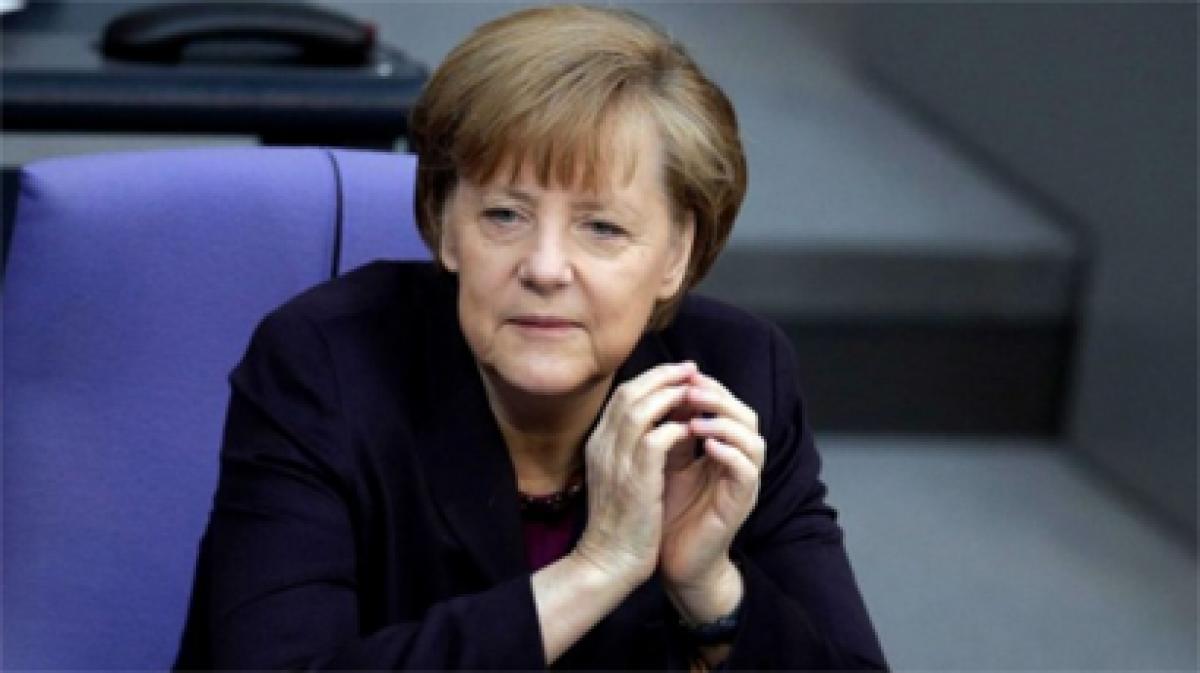Live
- South Korean FM Cho, Blinken hold talks on margins of APEC summit in Peru
- India’s insurance sector growth surpasses China, Thailand: McKinsey
- CLOSE-IN: Indian cricketers from Paupers to Princelings
- Delhi-NCR's air quality remains hazardous for residents
- South Korea, US, Japan to announce establishment of trilateral secretariat this week
- North Korean leader Kim orders mass production of suicide attack drones: KCNA
- Calcutta HC to hear next week plea for CBI probe into death of Jhargram Hospital doc
- Nigeria reports 15,000 AIDS-related deaths annually: Official
- The quicker Mohammed Shami gets fit and is on a flight, it's better for India, says Shastri
- BGT 2024-25: KL Rahul, Sarfaraz Khan suffer elbow in injuries; Virat Kohli taken for scans as India finish first practice session
Just In

German Chancellor Angela Merkel will open on Monday the exhibition \"The Art of the Holocaust\", featuring works created by concentration camp prisoners, as the German leader pledged to combat the threat of rising anti-Semitism.
German Chancellor Angela Merkel will open on Monday the exhibition "The Art of the Holocaust", featuring works created by concentration camp prisoners, as the German leader pledged to combat the threat of rising anti-Semitism.
The show brings together 100 works on loan from Israel's Yad Vashem Holocaust memorial by 50 artists created in secret between 1939 and 1945 while they were confined to the camps or ghettos.
Twenty-four of the artists did not survive the Nazi period. The drawings and paintings on display at Berlin's German Historical Museum depict the suffering, drudgery and terror of the conditions endured by the detainees.
But about a third of the collection shows artists' attempts to escape their plight with their imaginations, putting to paper treasured memories and dreams of freedom beyond the barbed wire.
Looking ahead to the opening in her weekend video podcast, Merkel said such exhibitions served as a crucial tool for educating younger generations.
She cited in particular the fears of German Jewish leaders that the need for imparting the lessons of the Holocaust had grown with the influx of a record 1.1 million asylum seekers to Germany last year.
"We must focus our efforts particularly among young people from countries where hatred of Israel and Jews is widespread," she said.
The head of Yad Vashem, Avner Shalev, said that the works on loan were irreplaceable "treasures".
They are "the expression of human beings under these unique circumstances to try and prevail... above the atrocities and deaths," he told reporters at a press preview of the exhibition.
"After thinking and rethinking, we thought it might be the right time, the right place, to bring this collection to Germany."
The only surviving artist, Nelly Toll, travelled to Berlin from the United States to take part in the opening.
Her two pencil-and-watercolour works were created when she was six years old and in hiding with her mother in a small room in the home of a Christian family in Nazi-occupied Poland in 1943.
One drawing shows two girls in a sun-dappled field wearing brightly coloured dresses with floral patterns enjoying each other's company, and their freedom.
The other, "By the Piano", depicts a character which she said was inspired by Cinderella and another, a princess, enjoying music together in a well-appointed salon.
'To leave a trace'
Toll said the scene might have been her family's own living room before they had to flee. "My memory and my imagination all blended," she admitted with a smile.
Painting and drawing allowed her to escape the loneliness, boredom and fear in the tiny annexe.
"They were very happy pictures. The figures you see almost became my friends," she said, adding that she had created 60 pieces by the end of World War II.
The bulk of the works in the exhibition, however, are stark testimonials to the savage treatment at the hands of the SS men and the fragility of daily life.
An artist named Jacob Lipschitz, who survived Dachau, immortalised his brother in a watercolour called "Beaten" showing his scabbed and scarred back with his head bowed after a vicious attack by guards.
A chilling ink drawing by Josef Schlesinger, "The Hanging of Nahum Meck", depicts the execution of a prisoner accused of shooting a guard while trying to escape the Kovno Ghetto, with other detainees forced to watch.
Alexander Koch, chairman of the German Historical Museum foundation, said it was the first major exhibition with artworks from Yad Vashem in Germany, a loan that he said "fills us with gratitude but also deep respect".
"These works speak to the cruelty of the Nazi regime but they are also a testament to daily survival in the camps," said Koch.
Curator Eliad Moreh-Rosenberg said many of the pieces were created in the certainty that they would send a message from the grave.
"The artists were conscious that they were painting for posterity," she said.
"It was their hope that something would survive for generations to come -- to leave a trace."
The exhibition will run until April 3.

© 2024 Hyderabad Media House Limited/The Hans India. All rights reserved. Powered by hocalwire.com







